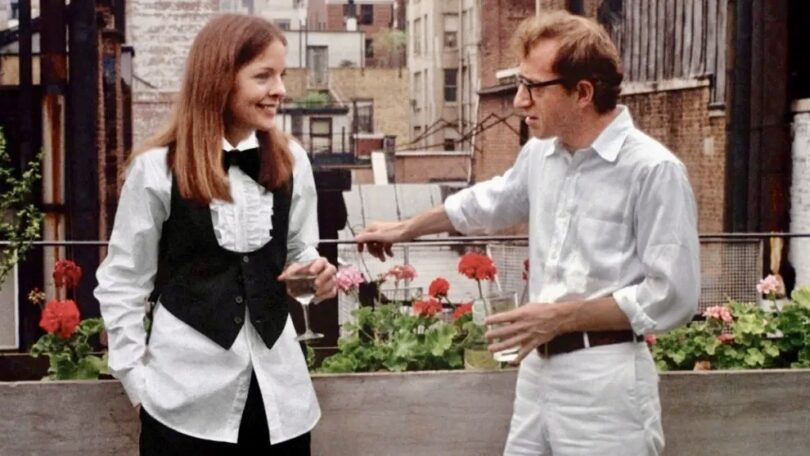Aw, Annie.
Why’d you have to go and die on us?
I’m talking about Diane Keaton, of course, who died Oct. 11 at age 79.
She appeared in more than 50 feature films, including the “Godfather” trilogy, “Manhattan” and “Reds.” But, for many of us Boomers who came of age in the 1970s, she’ll always be the sweet, charmingly eccentric girl of our dreams, Annie Hall.
Keaton – real name, Diane Hall – appeared to play a variation of herself in “Annie Hall” (1977), Woody Allen’s thinly disguised valentine to his ex-girlfriend.
The poignant romantic comedy traces the relationship of innocent, happy-go-lucky Californian WASP Annie and neurotic Jewish New York intellectual Alvy Singer (Allen) as they meet, fall in love, move in together, break up, and – SPOILER ALERT! – find a kind of bittersweet peace as friends. It won Oscars for best picture, best actress (Keaton), best director (Allen) and best original screenplay (Allen and Marshall Brickman).
It wasn’t the first collaboration between Keaton and Allen; it was the culmination of a comic partnership that gave us the Bogart-inspired “Play It Again, Sam” (1972), the futuristic satire “Sleeper” (1973) and Allen’s spoof of Russian literature, “Love and Death” (1975). Though marked by Allen’s sharp sense of humor, these three gag-filled films didn’t come across as personal or meaningful in the same way “Annie Hall” did.
And yet, “Play It Again, Sam” – based on a stage play by Allen – did mark breakthroughs for both Allen and Keaton.
In playing insecure, socially inept film critic (hmmm) Allan Felix, who gets romantic advice from the ghost of his celluloid hero, Humphrey Bogart, Allen represents a thinking person’s Everyman who wants so much to be cool like Bogie but doesn’t come close. He’s not handsome, he’s not suave, he’s not muscular or macho. But he is funny, in an often self-deprecating way. He wins the heart of Keaton’s Linda Christie, the out-of-his-league wife of his best friend, and plans to run away with her until – SPOILER ALERT! – he finds his inner Bogart and lets her go because it’s the noble thing to do.
For certain ’70s high school and college boys, Allen, as Allan, became an unlikely hero. And, as Linda, Keaton, funny and goodhearted and vulnerable and pretty and accessible and accepting (of someone like us!), became our ideal woman.
(Around this time I took a girl, Margaret – voted most beautiful in our high school class, but also smart and deep – to see “Play It Again, Sam” at a second-run Detroit movie theater. I parked around the corner from the neighborhood theater, in front of a house, and when we returned to the car after the movie was over, I opened the passenger door for her and she took her seat. The door got stuck in the grass and wouldn’t budge. So I rolled my eyes, threw my arms up in resignation, and fell backward onto the ground. Margaret laughed. “Now I know why you love Woody Allen,” she said.)
“Annie Hall,” elaborating on and digging deeper into the Keaton persona, made us love the actress even more. This wasn’t Diana Rigg, a different kind of ideal woman, so sophisticated and cool and unapproachable as Emma Peel in “The Avengers.” This was Diane/Annie, warm, easy with a laugh, someone with whom you might have gone to high school. And so incredibly endearing.
The culture embraced her. She landed on the cover of Rolling Stone (I remember eagerly reading the Ben Fong-Torres article, “The Life and Lurves of Diane Keaton,” at a campsite in Wexford, Ireland). Her casual style of dress – hats, vests over white shirts, ties, loose trousers – became a fashion sensation.
My three college apartment mates – Bur, Lip and J.R. – and I saw “Annie Hall” in Ann Arbor when it came out during our senior year at Michigan, and we were all big fans. By Oscar night, April 3, 1978, we’d all graduated. J.R. and I were back from hitching in Europe, Bur was working for a newspaper and Lip was going to law school.
We converged to watch the Oscars on TV at the house in Detroit where Lip lived with a bunch of other law students. (On the expressway on the drive there, I looked over and saw an old guy speeding along with no tire on one of his wheels. Sparks were flying. Ah yes, Motown.) When we arrived, Lip warned us that we’d have to be relatively quiet because people would be studying.
Good luck with that. We were there to root for Woody, and “Annie Hall,” and, perhaps most of all, Diane. And when they all won, the four of us cheered as if the Tigers had just won the World Series.
Keaton made four more movies with Allen, “Interiors” (1978), “Manhattan” (1979), “Radio Days” (1987) and “Manhattan Murder Mystery” (1993), and they reportedly remained friends for the rest of her life. She received three more Oscar nominations, for “Reds” (1981), “Marvin’s Room” (1996) and “Something’s Gotta Give” (2003). (When it was reported that she had a romance with Hollywood stud Warren Beatty, her co-star and director on “Reds” and the furthest thing from an underdog/Everyman, it felt like a betrayal.)
She also, before and after “Annie Hall,” played Kay, wife of Michael Corleone (Al Pacino), in the “Godfather” films. At this point it might be the role for which she’s best known, though I disagree with those who feel it’s among her best work. The same goes for her acclaimed portrayal of writer Louise Bryant in “Reds.” Some of her dramatic work seems forced.
She was at her best in comedy, especially opposite Allen, though her heartbreaking performance as Meryl Streep’s seriously ill sister in “Marvin’s Room” also stands out. What a pleasure to watch Keaton and Streep play off each other.
“Marvin’s Room,” along with “Sleeper” and “Play It Again, Sam,” would rank in my top four Keaton movies – with “Annie Hall” as No. 1. As an actress, Diane’s Annie was her peak, unique and unforgettable.
Most of us didn’t know the “real” Diane Keaton. The closest I got was attending a small press conference for her when she received the Hasty Pudding Award at Harvard.
But there was something about her, something that came through in “Annie Hall,” that made her seem more than just a movie star, more than just a figure on the screen. Something that leaves us mourning her as if she were an old friend, or a lost love from our youth. Something that leaves us grateful, and sad.
** Click here for Tim Miller’s previous movie columns for Cape Cod Wave **
Please like Cape Cod Wave on Facebook.
Cape Cod Wave Magazine covers the character & culture of Cape Cod. Please see our Longform stories.
Tim Miller is co-president of the Boston Society of Film Critics and a Tomatometer-approved critic. He teaches film and journalism at Cape Cod Community College in West Barnstable. You can contact Tim at [email protected] or follow him onTwitter @TimMillerCritic. Or you can ignore him completely.

































